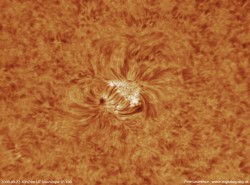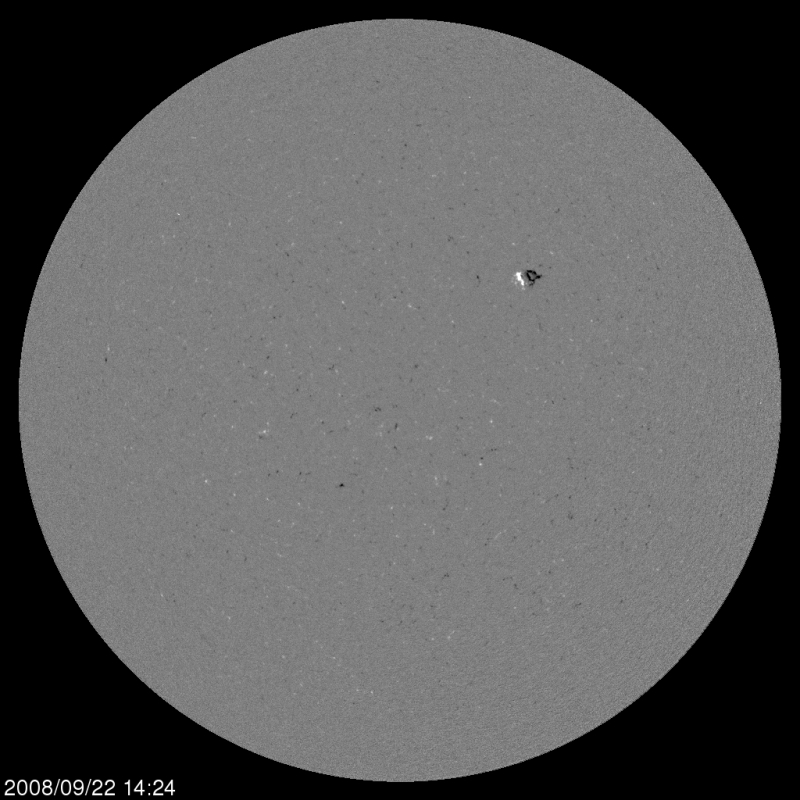[/caption]
After an extended period of calm for Solar Cycle 24, a cluster of sunspots have appeared on the disk of the Sun. Although we have observed sunspots since the beginning of this new solar cycle (which officially began on January 4th, 2008 with the observation of a high-latitude sunspot pair), this is the first time for many months “new” Cycle 24 sunspots have shown themselves. Before today, the sunspots (including occasional flares and coronal mass ejections) belonged to the previous cycle (Cycle 23). It would appear the spots have evolved into a cluster in a high-latitude location with the magnetic polarity consistent with this new cycle. But does this mean we can expect an increase in solar activity after this pretty dull period of “blank” solar disk observations? Your guess is as good as mine…
Overlapping solar cycles are natural occurrences, and extended solar minima are not unexpected, but many predictions of an extended period of solar calm have been put forward since Solar Cycle 24 appeared to shy away after the initial excitement in January. Although the Sun has been surprisingly quiet for several months, we’ve still had sporadic sunspot activity (plus the occasional flare and CME eruption), but none could be attributed to the new Cycle 24 (although I erroneously thought the August sunspot activity was due to Cycle 24, it was in fact due to the overlapping Cycle 23).

So how can we be so sure these new observations are of Cycle 24 spots and not Cycle 23 spots? After quickly glancing at the Solar and Heliospheric Observatory (SOHO) image (top), we can see a cluster of activity at a fairly high latitude. Generally speaking, one would expect sunspots at the beginning of a new cycle to appear at high latitudes. As the 11-year solar cycle progresses, sunspot activity will begin to drift equator-wards, to lower latitudes. “Old” Cycle 23 sunspots have generally appeared near the solar equator, so the sunspots observed today can be attributed to the “new” Cycle 24.
The clincher for identifying these spots as belonging to a new solar cycle is their magnetic polarity. Sunspots often appear in pairs of opposite polarity (i.e. one will be magnetic north, the other will be magnetic south), and this new cluster is consistent with the polarity expected for Cycle 24 sunspots. SOHO uses its Michelson Doppler Imager (MDI) Magnetogram instrument to observe magnetic polarity, and it would appear that the polarity of this sunspot cluster has an opposite magnetic north/south to previous Cycle 23 observations.
So does this mean we might see an increase in solar activity from here on in? Although this is an encouraging observation, the Sun could revert back to its “blank” state as quickly as it revealed these sunspots to SOHO. However, there is also a chance this could herald the beginning of accelerated solar activity, possibly still fulfilling NASA’s 2006 prediction that Solar Cycle 24 will be a “doozy.”
Watch this space…
Original source: Space Weather


Here we go. In a few more years we may be wishing we did not come to rely so heavily on satellite based telecommunications.
Lasted just one day.
It’s my fault, sorry, I finally bought a solar scope last year ..
Kinda like having the car washed or lighting the bbq bringing the rain !
alandee Says:
September 23rd, 2008 at 3:47 pm
“It’s my fault, sorry, I finally bought a solar scope last year ..”
Your new ‘scope curse is ruining it for us all! Take it back!!
February and still no sunspots; and yet nothing in the news. Global warming alarmist crushing anything that might hurt their agenda.